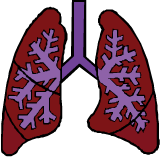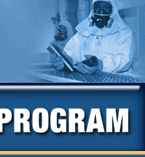Lung
Cancer Facts
What is Lung Cancer?
Cancer is a disease marked by the uncontrolled growth of abnormal cells. The abnormal cells no longer do the work of normal cells, and they crowd out and destroy healthy tissue. Most types of cancer cells form a lump or mass called a tumor. Another word for cancerous is malignant, so a cancerous tumor is referred to as malignant.
 Lung cancer begins in the lungs. Many lung cancers start in the lining of the air tubes (bronchi) but they can also begin in other areas such as the smaller branches of the air tubes (bronchioles) or the air sacs at the ends of these smaller branches (alveoli.) Cells from a tumor can break away and travel to other parts of the body where they can continue to grow. This spreading process is called metastasis. Lung cancer is a life-threatening disease because it often spreads in this way before it is found by conventional exams. Lung cancer begins in the lungs. Many lung cancers start in the lining of the air tubes (bronchi) but they can also begin in other areas such as the smaller branches of the air tubes (bronchioles) or the air sacs at the ends of these smaller branches (alveoli.) Cells from a tumor can break away and travel to other parts of the body where they can continue to grow. This spreading process is called metastasis. Lung cancer is a life-threatening disease because it often spreads in this way before it is found by conventional exams.
What Causes Lung Cancer?
A risk factor is something that increases a person’s chance of getting a disease. The two most significant risk factors associated with lung cancer are:
 |
 |
Cigarettes: Smoking cigarettes can cause lung cancer. Harmful substances, called carcinogens, in tobacco damage the cells in the lungs. Over time, the damaged cells may become cancerous. The more a person smokes and the longer the person smokes, the greater the risk of developing lung cancer. |
| |
 |
Occupational
exposures: Certain substances (such as asbestos, nickel compounds and beryllium) and radiation have been shown to increase the risk of lung cancer for workers. With certain substances, such as asbestos, the risk of lung cancer is multiplied if the worker also smokes. |
What
are the Signs and Symptoms of Lung Cancer?
Although most lung cancers do not cause any symptoms until they have spread, symptoms can occur in some patients with early lung cancer. You should report any of the following symptoms to your doctor right away. If lung cancer is found, prompt treatment can lead to a cure for some people and extend the life of others.
 |
 |
a cough that doesn’t go away and gets worse over time |
| |
 |
constant chest pain |
| |
 |
weight loss and /or decreased appetite |
| |
 |
coughing up blood |
| |
 |
shortness of
breath or wheezing |
| |
 |
hoarseness |
| |
 |
a fever for an
unknown reason |
| |
 |
recurring infections,
such as bronchitis and pneumonia |
| |
 |
fatigue |
The
best time to diagnose lung cancer is before there
are symptoms, when it is easier to treat.
What are
the Chances of Surviving Lung Cancer?
When lung cancer is diagnosed following the development of symptoms, just 15 of out of 100 people diagnosed will survive at least five years, for all lung cancers combined. If you only look at lung cancers detected in the early stages before they have spread to the lymph nodes and other organs, the survival rate increases dramatically to as high as 70%. In other words, 70 of every 100 people diagnosed at an early stage will survive for at least five years.
In addition, in June 2011, the National Cancer Institute (NCI) released results from its National Lung Screening Trial (NLST) that showed a 20 percent reduction in deaths from lung cancer among current and former smokers who underwent three successive, annual low-dose chest CT screenings, compared to a similar group (the “control group”) who underwent chest X-ray screenings.
You should be aware that false-positive CT scan findings sometimes occur and may lead to unnecessary anxiety, testing, and surgery.
The Worker Health Protection Program is pleased to be able to offer low-dose, spiral CT scans to both hourly and salaried workers. The attached factsheet explains how spiral CT can help to detect lung cancer in the early stages when it is most likely to be treatable. Your decision to participate in the program is entirely voluntary.
|



 Lung cancer begins in the lungs. Many lung cancers start in the lining of the air tubes (bronchi) but they can also begin in other areas such as the smaller branches of the air tubes (bronchioles) or the air sacs at the ends of these smaller branches (alveoli.) Cells from a tumor can break away and travel to other parts of the body where they can continue to grow. This spreading process is called metastasis. Lung cancer is a life-threatening disease because it often spreads in this way before it is found by conventional exams.
Lung cancer begins in the lungs. Many lung cancers start in the lining of the air tubes (bronchi) but they can also begin in other areas such as the smaller branches of the air tubes (bronchioles) or the air sacs at the ends of these smaller branches (alveoli.) Cells from a tumor can break away and travel to other parts of the body where they can continue to grow. This spreading process is called metastasis. Lung cancer is a life-threatening disease because it often spreads in this way before it is found by conventional exams.